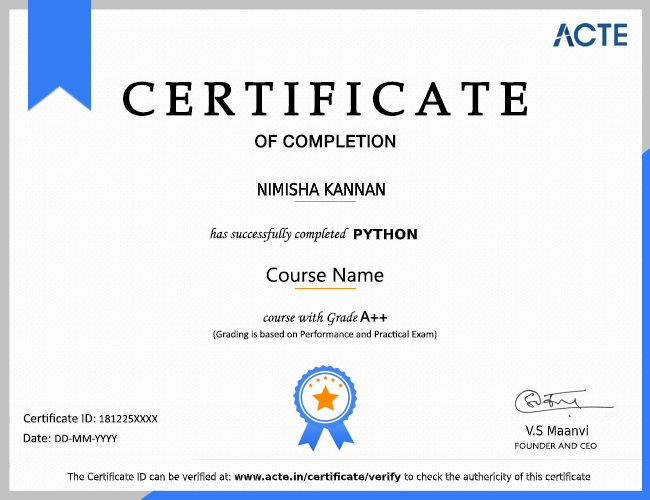The C & C++ Certification Class is full of industrial projects for students to take part in. The schedule is based on C++. If you understand this, you can learn any programming language. Trainers remember these things. These things, ACTE offers the C & C++ Training in Mumbai. C & C++ was the first language I really did, but my work was mostly an academic or a game planner. Most of the programs in which I live require Java or .NET programmers, and I know the core language technology that they require. For example, a Java programmer might need to know the EJB, servers, hibernate, spring and other technologies, libraries, and frames. If you are seeking an online certification course in C++, there's no better choice. Programmable learning is a necessary condition for beginning your software career. All topics are addressed in online certification courses with examples from real life.
Additional Info
C++ is a computer language based on the C language. It is pronounced "C plus plus." C++ has a similar syntax to C, but it has object-oriented capabilities that allow the programmer to build objects inside the code. This makes programming simpler, more efficient, and even enjoyable for some. Most software applications nowadays are built in C++ due to the language's strength and versatility. C++ is still popular today because of its remarkable portability, which allows programmers to quickly write applications that operate on a variety of operating systems and platforms. Despite being a high-level language, C++ may be used to manipulate low-level data because of its tight relationship with machine language.
Object-oriented programming was only getting started when C++ was released. With the promise of more advanced virtual data types and objects, this innovative kind of computer programming revolutionized the coding world. An object is a data type in object-oriented programming that includes both data and functions built into its architecture. Prior to the introduction of object-oriented programming, programmers viewed a codebase as a collection of separate command-line commands. The recognition of objects with built-in data and functionalities resulted in a new approach to packaging and automating code development.
The differences between C and C++ are as follows :
C is a structural programming language that does not support the idea of classes and objects, whereas C++ is an object-oriented programming language that does.
C++ is an object-oriented programming language that supports the idea of classes and objects, whereas C supports the structural programming language where the code is verified line by line.
C++ is a programming language that is a superset of C. C++ can execute 99 percent of C code, while C cannot execute C++ code.
C++ uses a bottom-up technique, whereas C uses a top-down one. The top-down method divides the major modules into tasks, which are then divided into sub-tasks, and so on. The bottom-up method prioritizes the development of lower-level modules before moving on to higher-level modules.
Outsiders may readily manipulate data in C because it lacks encapsulation and information hiding, but C++ is a very secure language that provides both encapsulation and data hiding, making it impossible for outsiders to alter its data. Functions and data are free entities in the C language, but all functions and data are contained in the form of objects in the C++ language.The feature of function overloading allows you to have several functions with the same name but different arguments. Function overloading is not supported in C; nevertheless, it is supported in C++. Function overriding is a feature that allows you to customize a function that is previously defined in the base class. Function overriding is not supported in C; nevertheless, it is supported in C++. Reference variables are not supported in C, although they are supported in C++.C++ supports 52 keywords, while C has 32 keywords. A namespace is a feature that organizes things such as classes, objects, and functions into a logical hierarchy. The namespace feature in C is absent, whereas the namespace feature in C++ prevents name conflicts.
Why You Choose?
1. The learning curve is quite steep :
Many people begin their programming careers by learning C or C++, but few continue to learn and master these two languages because they become frustrated when dealing with low-level programming elements like pointers, memory storage models, address alignment, template expansion, multi-thread data races, and so on. The software will have a significant chance of crashing if these aspects are not handled appropriately, which will upset the inexperienced coder.
2. In current application development, it is rarely utilized :
Nowadays, we have numerous modern programming languages for application development, such as Java, C#, Python, Javascript, Go, and others, and it would seem insane to create a Web application or backend service in pure C/C++. More sophisticated programming languages have taken over the popular application areas, such as:
- Web front-end development : Everything is written in Javascript/Typescript, and the three most popular front-end frameworks are Angular, React, and Vue.
- The most common technologies used in web back-end service development are Javascript (Node), Python (Flask, Django), Java, and PHP.
- QT (PyQT, C++), Electron (Javascript), and WPF (C#) are examples of desktop application development.
- iOS (Objective-C, Swift) and Android application development (Java).
- Java, Go, Groovy, and Scala is examples of distributed systems, big data, and cloud computing.
- Python is used for data science, AI (Artificial Intelligence), and ML (Machine Learning).
Roles & Responsibilities :
C++ programmers create desktop and mobile software applications, as well as embedded devices, using the C++ programming language. They work with stakeholders to establish application needs, install software, and keep software systems running smoothly. They also help with software optimization and development.
- Consultation with internal stakeholders to establish the scope of software development projects is one of the responsibilities of a C++ developer.
- Working on application design and development alongside the software development team.
- Developing software and supervising application deployment across many platforms.
- Diagnostic testing and debugging processes are carried out.
- Creating feedback channels for end-user applications.
- Maintenance, updates, and upgrades are all part of optimizing software.
- Maintaining software development records and documenting methods.
- Keeping up with C++ standards and application development advances.
Modules :
1. Import Regulations :
The simple use of a module is demonstrated in the following example. The standard library is encapsulated in this case by the module. int main() std::cout “Hello Worldn”; import std; / Module import directive.
A module import directive (or simply an import directive) is the first sentence in this example. In the translation unit, such a directive makes a set of declarations available. Module import directives, unlike #include preprocessor directives, are unaffected by macro expansion (save for the identifiers contained in the directive).
Modules have their namespace, apart from the rest of the language's namespaces. As a result, a module and, for example, a C++ namespace might have the same name. In the case above (where the module name std is identical to the primary namespace being imported), Modules in C++ N3347=12-0037 are assumed. This technique is also likely to be popular in module-based libraries. (However, this isn't a necessity; in fact, a module might include bits. numerous namespaces in C++). As a result, the std in std::cout does not relate to the module. name std, however it refers to a namespace named std that is included in the std module.
2. Definitions of Modules :
Let's look at how to define (rather than how to utilize) a module. / File 1.CPP: export Lib: / Header for module definitions. All declarations must be preceded by a comma. std::cout “S()n”; import std; public: namespace N struct S S() std::cout “S()n”; / import Lib; int main() N::S s; int main() N::S s; int main() N::S s; int main() N::S s; int main() N::S s; int main. All declarations in a translation unit must be preceded by a module definition header: It means that some of the declarations that follow might be used in other translation units. Import directives only make members of a module that have been made "public" visible (these are also called exported members). To accomplish this, the access labels "public:" and "private:" (but not "protected:") are expanded to include not just class member declarations, but also namespace member declarations in module definitions.
Exception handling is not supported directly in C; it must be accomplished through the usage of exception-handling functions. A try-catch block in C++ offers direct support for exception management. In C, the scanf and printf functions are used for input and output, whereas in C++, the cin and cout functions are used for input and output, respectively. For memory allocation, C provides the calloc() and malloc() methods, as well as the free() function for memory deallocation. In C++, a new operator for memory allocation and a delete operator for memory deallocation are available. Inheritance is a feature that enables a child class to utilize the parent class's properties. Inheritance is not supported in the C language, although it is supported in C++. The stdio.h header file is used by C programs, while the iostream.h> header file is used by C++ programmes.
Benefits :
- is a middle-level language that includes elements from both high- and low-level languages. It may be used for low-level programmings, such as driver and kernel scripting, and it can also support high-level programming languages, such as software application scripting.
- C is a structured programming language that allows you to break down a large program into smaller programs known as functions. It also permits data to flow freely between these functions.
- The C programming language is case-sensitive.
- C is a highly portable programming language that is widely used in Windows, UNIX, and Linux operating systems for scripting system programs.
- C is a general-purpose programming language that may be used to create business applications, games, graphics, and calculation-intensive applications.
- The C programming language comes with a large library of built-in functions. It also has a memory allocation system that is dynamic.
Framework :
Qt framework :
More than online and game development, the Qt framework for C++ developers is thought to be perfect for software development. From the same platform, you can develop independent software and apps for embedded devices like never before. The Qt framework is used in a variety of industries, including automotive, automation, medical, and embedded devices. You may develop cross-platform programs that run on anything from smart home devices and automobiles to workplaces and smartphones. Multinational corporations like LG, Panasonic, AMD, Mercedes-Benz, Denso Automotive, and others use the Qt framework to develop integrated and cross-platform apps that set their goods apart from the competition.
A framework is a collection of pre-built software components that programmers may utilize, modify, or alter for specific computer solutions. Developers don't have to start from scratch every time they build an application thanks to frameworks.
Certification :
The C++ Institute offers the following certifications :
- CPA (C++ Certified Associate Programmer Certification) is a certification for C++ programmers :
This C++ certificate proves that you understand the fundamentals of C++ and can create programs independently. This certification requires you to be well-versed in computer programming principles, OOPS, standard C++ libraries, fundamental data types, and problem-solving techniques.
- CPP (C++ Certified Professional Programmer Certification) is a certification for C++ programmers :
This is the next level of qualification, and the CPA certification is required. It's a professional certification that verifies your understanding of advanced C++ topics such as templates, the standard template library, third-party templates, advanced STL input-output operations, and so on.
- C++ Certification with a Star :
In the United States, the Star C++ Certification is a highly regarded certification that gives an in-depth understanding of the topic. The certification course covers the fundamentals of OOPS before moving on to more complex subjects such as C++ data structures, pointers, input-output operations, exception handling, and more.
- Certification in C++ with a Star :
The Star C++ Certification is a highly respected certification in the United States that provides an in-depth grasp of the field. Before going on to more sophisticated topics like C++ data structures, pointers, input-output operations, exception handling, and more, the certification course covers the foundations of OOPS.
- Certification in C++ by PCE :
PCE (Professional and Continuing Education) is a term used by the University of Washington, one of the most prestigious public colleges in the United States. It offers certificates in a variety of fields that may significantly boost the value of your CV. The C++ certification program is an intensive eight-month course that covers all areas of C++ programming, from the fundamentals to the advanced. To make this certification, you must have a solid grasp of C programming language principles and at least 2 years of programming experience in a high-level programming language.
- edX's Basic C++ Certification :
Although the basic course is free, you must spend $99 to receive a validated certification, which is well worth it because it is signed by the teacher and can be simply added to your CV. There are no prerequisites for this beginning course.
Pay Scale :
The average C++ Programmer salary in the United States was 80K however, salaries generally vary from 73K to 85K. In India, the highest annual compensation for a Developer C/C++ is 146K. In India, the lowest annual pay for a Developer C/C++ is 304K.
































